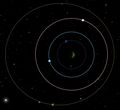Jool/pl
Jooljest Gazowym olbrzymem i szóstą planetą w systemie Kerbol. Jest najbardziej oddaloną planetą i bardzo trudną do osiągnięcia. Jest jednak jednym z najbardziej interesujących celów misji ze względu na swój skomplikowany układ pięciu księżyców:: Laythe, Vall, Tylo, Bop, oraz Pol. Orbity dobrze dostosowane do płaszczyzny orbity, i wiele skrzyżowań z orbitami księżyców, mogą być łatwo przechwycone przez księżyce z niewielka zmianą prędkości ΔV.
Atmosfera
|
Mimo, że Jool ma promień 10 razy większy niż Kerbin, jego atmosfera zaczyna się 2 razy wyżej (138.2 km). Jest również bardzo gęsta, dobrze nadaje się do hamowania aerodynamicznego. O Orbitowanie zaraz ponad atmosferą daje okres orbitalny równy 94.7437 minutom, i prędkość 6,785 m/s. Zazwyczaj nie trzeba schodzić poniżej 60 km, aby rozpocząć hamowanie aerodynamiczne. Ogólnie, ciśnienie atmosferyczne w Joolu dla wysokości wyrażonej w metrach: Im bliżej powierzchni tym fizyka w grze zaczyna się psuć.Ze względu na bardzo gęstą atmosferę, prędkość maksymalna jest tak niska, że lżejsze pojazdy nie potrzebują spadochronów ani napędu. Nie jest to niemożliwe, aby wylądować na twardej powierzchni, lecz statek może zostać zniszczony przez anomalie. Kerbal w trybie EVA nie będzie zniszczony, możliwe jest tylko lądowanie. Jednak jak widać pod koniec tego filmu, kerbal będzie zbugowany. to się dzieje tylko jeżeli użyjesz przysp czasu 4x. Spowoduje to w pewnym momencie czarny ekran. Dopóki nie zrestarujesz gry, Kerbin nie będzie miał atmosfery. |
Naturalne Satelity
 The ocean moon Laythe, about to transit Jool. Jool has five natural satellites:
Laythe, Vall, and Tylo are in a Laplace resonance, with orbital periods of 1:2:4 respectively. Despite the fact that the moons can easily eclipse both each other and Jool, they do not. Gallery
Trivia
Changes
|
||||||




